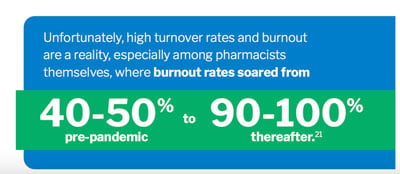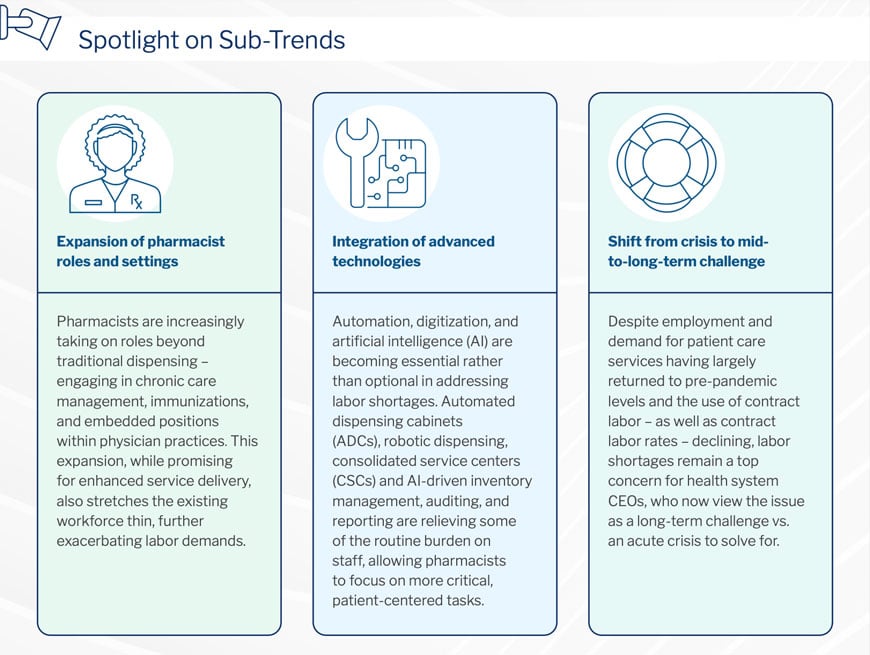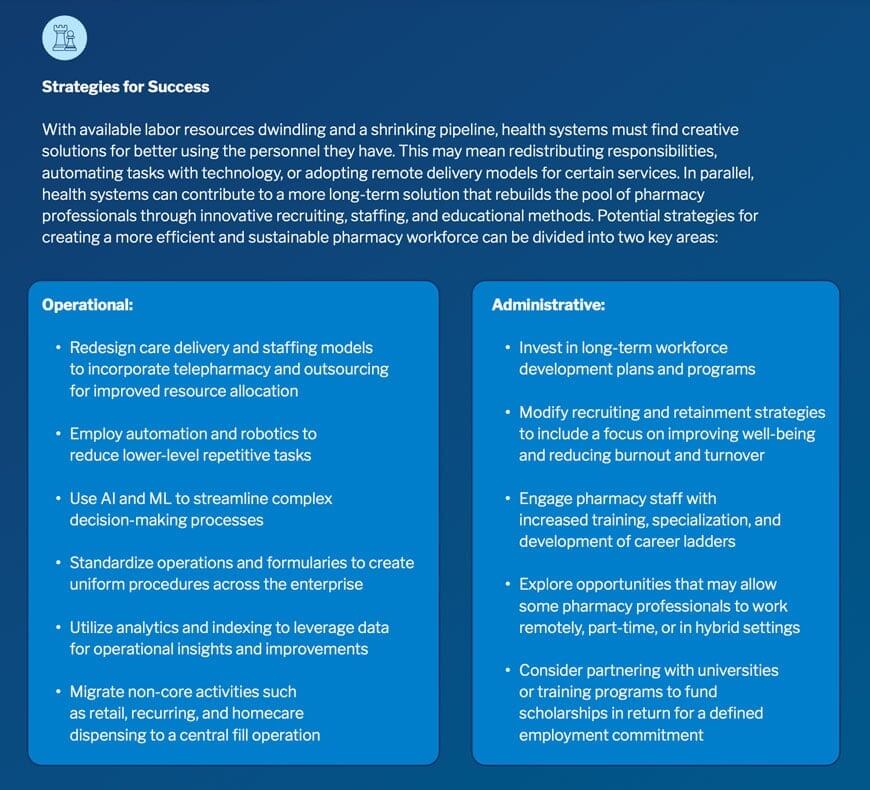
Hospital leaders discuss ambulatory pharmacy strategies, 340B considerations, and value-based care optimization at McKesson's Becker's Roundtable session.
With available labor resources dwindling and a shrinking pipeline, health systems must find creative solutions for better using the personnel they have.
By
Date
February 18, 2025
Read Time
4 minutes

The collective healthcare sector is experiencing significant labor shortages – with multiple surveys reflecting labor shortages as a top operational and financial concern for health system leaders – and the pharmacy is being hit particularly hard. The U.S. Bureau of Labor Statistics (BLS) estimates that there are 14,200 openings for pharmacists each year, and the Health Resources and Services Administration (HRSA) projects shortages of up to 5,000 pharmacists over the next 15 years.1,2 Pharmacy technician roles are some of the most difficult to fill, and research appears to show the problem may only worsen. According to BLS, growth is dramatically slower (7% annually) in pharmacy technicians than other professions, with up to 47,000 openings each year.3 In 2021, pharmacy technicians experienced a 20% turnover rate.3 Taking into account the 20% turnover rate with just a 7% growth rate, the deficit will continue to grow.
 Trends in training and education also support the possibility of ongoing pharmacy labor shortages, as the American Association of Colleges of Pharmacy (AACP) notes a 10% reduction in pharmacy student graduation rates and a worrisome 60% decline in pharmacy school applicants over the last 10 years which is thought to be fueled, in part, by would-be applicants’ perception of the profession as having a high risk for burnout.3,4 While it remains to be seen whether the trend will continue, high turnover rates and burnout are a reality, especially among pharmacists themselves, where burnout rates soared from 40-50% pre-pandemic to 90-100% thereafter.4
Trends in training and education also support the possibility of ongoing pharmacy labor shortages, as the American Association of Colleges of Pharmacy (AACP) notes a 10% reduction in pharmacy student graduation rates and a worrisome 60% decline in pharmacy school applicants over the last 10 years which is thought to be fueled, in part, by would-be applicants’ perception of the profession as having a high risk for burnout.3,4 While it remains to be seen whether the trend will continue, high turnover rates and burnout are a reality, especially among pharmacists themselves, where burnout rates soared from 40-50% pre-pandemic to 90-100% thereafter.4

Labor shortages in pharmacy services significantly impact health systems' ability to deliver effective patient care. Shortages can lead to delays in medication dispensing, increased errors, and reduced patient interaction while also contributing to burnout and turnover that compounds labor constraints. From a financial perspective, health systems could lose valuable dollars due to reliance on contract labor, continuous training and onboarding as a result of high turnover, decreased revenue from clinical services, and various operational demands directly related to short-staffed pharmacies.
It’s widely accepted that labor shortages will continue to plague the pharmacy profession for the foreseeable future, though potential solutions are emerging and evolving rapidly. Health systems should closely monitor proposed changes in state and federal laws that may alter reimbursement models based on the broader role of the modern pharmacy professional. The development and availability of technologies and automated solutions that may help streamline pharmacy operations, speed up decision-making, and reduce labor demands should also be followed.5,6
“The key to solving for pharmacy labor shortages isn’t just about hiring more staff. You’ve got to find ways to better utilize who and what you have. That starts with exploring technology and rethinking how and where care is delivered – and by whom – so that our pharmacy professionals can operate at the top of their license.” – Craig Dolan, BSPharm, PharmD, MBA, Vice President, Knowledge Management & Thought Leadership

Many of McKesson’s Professional & Advisory Services (P&AS) experts began their careers as health system pharmacists, and solving for labor shortages – both acutely, through efficiency strategies and solutions, and more broadly with efforts to build and develop the workforce long term – is equal parts personal and professional priority.
For health systems feeling the strain of pharmacy labor shortages, our P&AS team can discuss how our advanced offerings, including central fill options, CSCs, Contract Concierge, and others can help alleviate your most pressing operational and administrative burdens so you can achieve more – even with less.
For more information about how our P&AS experts can help you combat labor and resource constraints to achieve more for the business of pharmacy, contact us directly at pas@mckesson.com.
1 https://www.bls.gov/ooh/healthcare/pharmacists.htm
2 https://bhw.hrsa.gov/data-research/projecting-health-workforce-supply-demand
3 https://www.bls.gov/ooh/healthcare/pharmacy-technicians.htm#tab-6
https://www.pharmacypracticenews.com/Opinion/Article/06-24/Addressing-the-Decline-in-Graduating-Pharmacists-The-Role-of-Artificial-Intelligence-and-Automation/74011#:~:text=Recent%20data%20indicate%20a%20notable,60%25%20within%20the%20last%20decade.
4 https://www.drugtopics.com/view/student-staffing-shortages-continue-to-impact-pharmacy-profession?utm_source=www.drugtopics.com&utm_medium=relatedContent
5 https://bringoz.com/retail-pharmacy-trends-that-will-impact-2024/#:~:text=The%20retail%20pharmacy%20industry%20in%202024%20is%20poised%20for%20innovation,and%20technology-driven%20healthcare%20solutions
6 https://www.pharmexec.com/view/four-for-2024-predictions-for-the-future-of-pharmacy-technology